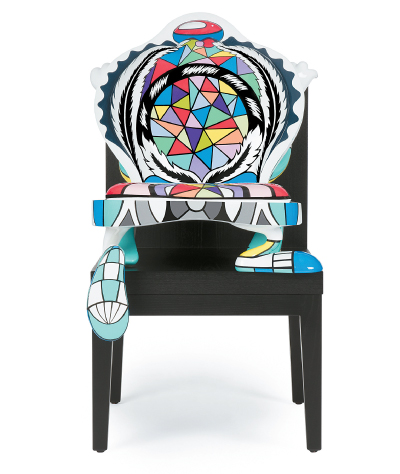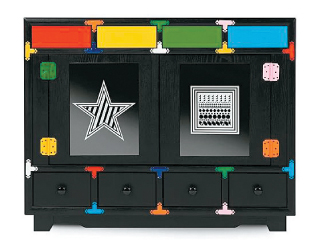Furniture artist Ham Doha adds character to tradition

“Harmony” (2018) is a personified chair created by artist Ham Doha. [HAM DOHA]
Painted in vivid colors like turquoise blue and bright yellow, they are like cartoon characters with humanlike arms and legs frozen in motion, peeking out timidly or holding up a fist ready to fight.
Ham calls his work art furniture. His pieces are delicate and often feature hand-painted drawings and innovative shapes, yet serve a functional purpose.
“They are furniture, but they are [also] art pieces that connect furniture to furniture,” said Ham. “The basic element of my work is that they all have uses. Just because they’re called art furniture doesn’t mean they’re only pleasing to the eye. You should be able to use them as a chair, or to place sculptures.”

“Mirror Meoritjang” (2017) is one of several traditional chests of drawers created by Ham. Keeping traditional elements like mother-of-pearl, Ham added neon colors and geometric shapes. [HAM DOHA]
The animated chairs are sold together with plain black, angular chairs - also made by Ham - that can serve as displays for the colorful chairs.
Ham, who holds a Master of Fine Arts in wood working & furniture design from Hongik University, said he got into the field because he “didn’t like uniform furniture.”
But making furniture, let alone decorating it with paint or mother-of-pearl is a long process that is daunting to many artists interested in entertaining the world of furniture design.
“It takes me around one month to finish one piece since I paint everything by hand with acrylic paints,” said Ham. “There aren’t many artists in Korea who do art furniture as it is not a pure art form. And it takes a long time, with costly materials. Plus, there’s no established sales route.”
But Ham’s creativity and perseverance seems to have paid off, as his pieces have landed prominently in the living rooms of people like the trade commissioner for Finland in Korea. Ham has also done collaborative projects with designers Kuho and Grafflex.
Some of Ham’s more recent works include his take on the meoritjang, or traditional Korean chest of drawers. Although they don’t feature dangling limbs this time, Ham incorporates his own style by adding radical colors like neon orange and geometric shapes.
“The reason why people don’t use the meoritjang these days is because they’re so old and the colors are dreary,” said Ham. “I try to keep most of the classic methods of making traditional furniture, like ink smearing, but I wanted the closets to be like an accessory.”
Although Ham said he doesn’t deliberately take inspiration from traditional Korean symbols or imagery, things that he comes across in everyday life become motifs for his works.
“I get inspired by our country. The sources could be a traditional women’s jacket with multicolored sleeve or a traditional patchwork, reinterpreted in a modern way. They could be also flowers on the streets like azalea and forsythia.”
As an artist who’s been active for a decade, Ham was honest in speaking about what really motivates him.
“Money is the most important thing,” he said. “If my artworks are sold, it becomes the driving force and motivation for me to prepare my pieces in the coming year. I need money to keep experimenting and produce better works.”
“I also want my artwork to be on display and in exhibitions. If I keep a Hermes or Chanel handbag in the closet, it will just rot away. I think artworks that travel a lot, even if they get scraped or dirtied, are more beautiful than works that have been stored away for a long time.”
BY KIM EUN-JIN [kim.eunjin1@joongang.co.kr]










with the Korea JoongAng Daily
To write comments, please log in to one of the accounts.
Standards Board Policy (0/250자)